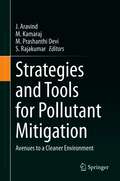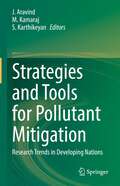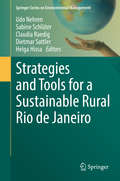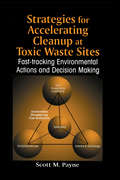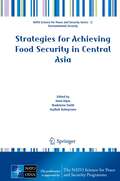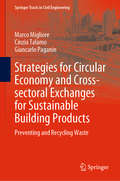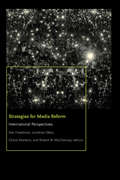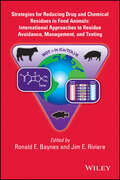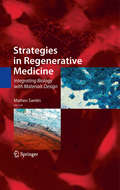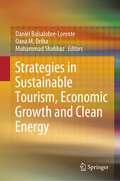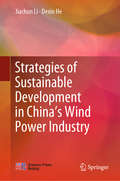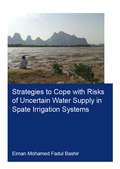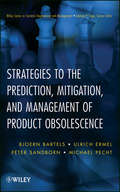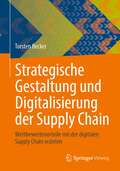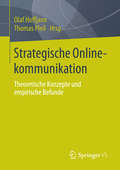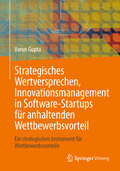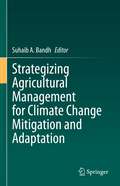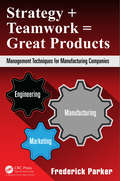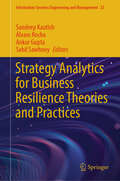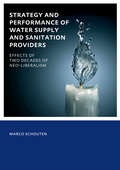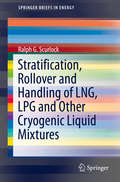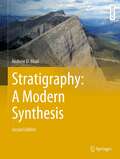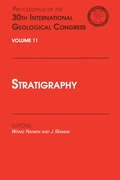- Table View
- List View
Strategies and Tools for Pollutant Mitigation: Avenues to a Cleaner Environment
by J. Aravind M. Kamaraj M. Prashanthi Devi S. RajakumarThis volume explores recent research trends and achievements in environmental pollution remediation (e.g. water, air, soil), and compiles critical and constructive papers and reviews with a focus on advances in bioremediation and green technology solutions for waste minimization, waste management and pollution control. The book is timely, as the need for researchers and engineers to develop sustainable and green eco-friendly remediation technologies is increasing with a growing global population, stressed agricultural systems, and an environment impacted by climate change. A key focus of the book is on the efficient use of agricultural waste residues as viable substrates for creating materials for environmental clean-up, and the possible conversion of these pollutants to sustainable bioresources. The volume will be of interest to sustainability researchers, environmental engineers, industry managers and agricultural scientists.
Strategies and Tools for Pollutant Mitigation: Research Trends in Developing Nations
by J. Aravind M. Kamaraj S. KarthikeyanThis book offers an overview of the latest work in environmental remediation and waste management coming out of developing nations. It is split into two sections: one on state-of-the-art sustainable remediation approaches, and the other covering waste management for a cleaner environment The ten chapters in this book are structured as reviews that assimilate recent works in these areas; they provide a centralized resource for scholars in developing nations who are working in environmental remediation and waste management. The volume will be of interest to sustainability researchers, environmental engineers, industry managers and agricultural scientists.
Strategies and Tools for a Sustainable Rural Rio de Janeiro (Springer Series On Environmental Management Ser.)
by Udo Nehren Sabine Schlϋter Claudia Raedig Dietmar Sattler Helga HissaThis book is a compilation of recent developments in land, ecosystem, and water management in the Brazilian state of Rio de Janeiro. The state is located in the biodiversity hotspot of the Atlantic Forest (Mata Atlântica), a biome characterized by high biological diversity and endemism. At the same time the state of Rio de Janeiro emerged to one of the economic hubs in Latin America. This development process has been accompanied by population growth, industrialization, urbanization, as well as consumption and degradation of land and water resources. In the past years many efforts have been made to stop or at least slow down these degradation processes and restore degraded environments with the overall goal to bring together sustainable management of natural resources, nature conservation, and economic development. An overview is provided of the different strategies and tools that have been developed in the fields of agriculture, ecosystem management and biodiversity, integrated water management, land restoration, disaster risk reduction and climate change adaptation, as well as environmental governance and economic instruments. This book covers a wide spectrum from applied research to science‐policy interfaces, planning concepts, and technical tools and has a model character for other rural areas in Latin America. Target groups are scientists, practitioners, policy makers and graduate students in the field of environmental management. The different chapters are written by researchers and practitioners of the German‐Brazilian project INTECRAL (Integrated Eco Technologies and Services for a Sustainable Rural Rio de Janeiro), the rural development program Rio Rural under the state secretary for agriculture and animal husbandry, as well as invited scientists from Brazilian universities and research institutes. It bridges existing gaps between science, policies, and practice in rural development.
Strategies and Trends in Organizational and Project Management (Lecture Notes in Networks and Systems #380)
by Pavel V. Trifonov Marina V. CharaevaThis book includes the papers presented at the II International Applied Research Conference “Operations and Project Management: Strategies and Trends” and the International Research Conference “Management in Financial Economy” held in Rostov-on-Don on May 19–20, 2021 within the framework of the South Russia Business Education Forum. The articles included in the book present a comprehensive analysis of the problems of adaptation of traditional and new methods of operational and project management, development of technologies for business process and supply chain management, development trends in financial economy discussed both on a global scale and in the context of sustainable socio-economic development at the meso-level of regions and industries, which not only reveals the nature of the ongoing processes, but also demonstrates their specifics in industry, agriculture, service industry in Russia, CIS countries, Europe, and China. Particular attention is paid to business education in the new economic realities. The polemical focus of the above-mentioned issues in conjunction with the accuracy of the presented analytics makes it possible to come to unconventional, though practically realizable solutions.
Strategies for Accelerating Cleanup at Toxic Waste Sites: Fast-Tracking Environmental Actions and Decision Making
by Scott Marshall PayneAccelerating Cleanup at Toxic Waste Sites: Fast-tracking Environmental Actions and Decision Making presents truly innovative advances in investigative and cleanup technologies, offering valuable solutions that streamline the data collection process, speed up the time it takes to characterize a site, and expedite decision making.Using easy to understand graphic displays, tables, text summaries, and real world case studies, and by synthesizing technical and regulatory reference information crucial to the development of effective cleanup strategies, this book provides the framework for environmental professionals to develop project and program approaches that meet today's needs.An advanced text for those with at least basic understanding of environmental investigation, cleanup, regulations, decision making, and policy development, Accelerating Cleanup at Toxic Waste Sites addresses the "human" side of the environmental industry and why it is perhaps one of the most important considerations for successful accelerated cleanup. This book takes the next step by providing managers, project teams, and other professionals with approaches that bring techniques, regulations, strategies, and people together into one comprehensive package that works.
Strategies for Achieving Food Security in Central Asia
by Hami Alpas Asylbek Kulmyrzaev Madeleine SmithFood Security is a primary concern for all countries. However the vulnerabilities which need addressing are dictated by the individual country according to the food control systems in place, the nature of the food industry and the culture of the country. This book summarises the presentations of a NATO Advanced Training Course addressing the issue of food security in Central Asia. The book is divided into two sections. The first provides an overview of the existing aspects of food security in participating Central Asian countries. The emphasis here is on food safety, control and access and includes background information on the relevant food industries. Participating countries include the Kyrgyz Republic, Kazakhstan, Uzbekistan and Tajikistan. The second section explores particular aspects of food security in participating NATO countries. These provide some insight into the value, strengths and weaknesses of common food security systems. Chapters cover HACCP, ISO/IEC 17025 standards and associated pre-requisite systems, allergies and food intolerances, risk perception and communication, training, and ethics. A chapter on food defence in the USA is also included. This book is suitable for anyone with an interest in food control systems and food security.
Strategies for Circular Economy and Cross-sectoral Exchanges for Sustainable Building Products: Preventing and Recycling Waste (Springer Tracts in Civil Engineering)
by Cinzia Talamo Marco Migliore Giancarlo PaganinThis book offers a valuable tool for understanding current efforts to promote the reuse and enhancement of pre-consumer waste in the development of new products for the construction sector, as well as the financial and regulatory tools being used to support this trend. It explores the vast and complex topic of the circular economy from the perspective of strategies for the reuse/recycling of waste, and develops a number of key premises: waste reuse/recycling must be considered using a logic of cross-sectoriality, recognizing the need to enhance the “dialogue” between different sectors; pre-consumer waste is particularly interesting for the recycling market because the construction sector can reduce its environmental impacts by enhancing its capacity to use secondary raw materials and by-products from other sectors; and lastly, the manufacturing sector is currently experimenting with promising forms of reducing/recycling pre-consumer waste and is at the same time providing by-products that can be used in other production chains. As such, the book offers a valuable asset for professionals who are interested in sustainability in construction, and in the study of construction products; however, it will be equally useful for local decision-makers tasked with implementing development policies and innovations in the industrial sector.
Strategies for Media Reform: International Perspectives (Donald McGannon Communication Research Center's Everett C. Parker Book Series)
by Jonathan A. Obar Cheryl Martens Robert W. McChesneyMedia reform plays an increasingly important role in the struggle for social justice. As battles are fought over the future of investigative journalism, media ownership, spectrum management, speech rights, broadband access, network neutrality, the surveillance apparatus, and digital literacy, what effective strategies can be used in the pursuit of effective media reform?Prepared by thirty-three scholars and activists from more than twenty-five countries, Strategies for Media Reform focuses on theorizing media democratization and evaluating specific projects for media reform. This edited collection of articles offers readers the opportunity to reflect on the prospects for and challenges facing campaigns for media reform and gathers significant examples of theory, advocacy, and activism from multinational perspectives.
Strategies for Reducing Drug and Chemical Residues in Food Animals
by Jim E. Riviere Ronald E. BaynesHighlighting international approaches; the book details strategies to minimize contamination, residue monitoring programs, and classes of drugs and chemicals that pose contaminant risk in livestock. Focuses attention on drug and chemical residues in edible animal products Covers novel computational, statistical, and mathematical strategies for dealing with chemical exposures in food animals Details major drug classes used in food animal production and their residue risks Highlights efforts at harmonizing and the differences among areas like US, EU, Canada, Australia, South America, China, and Asia, where the issue of chemical exposures has significant impact on livestock products Ties veterinary clinical practice and the use of these drugs in food animals with regulatory standards and mitigation practices
Strategies in Regenerative Medicine
by Matteo SantinThis authoritative book offers a detailed overview of present and future tissue engineering approaches and their contribution to regenerative medicine. It combines comprehensive reviews of the biology and materials science underlying the development and regeneration of different types of tissues with descriptions of current and future strategies in regenerative medicine to meet clinical needs. Each chapter includes typical examples of methodologies and technical solutions as the basis for the most recent scientific findings and biomedical products, tables as mini-databases summarizing the most recent findings, and links to specific websites in the main body of the text to complement a traditional reference list. Strategies in Regenerative Medicine: Integrating Biology with Materials Design covers topics from basic biology and materials science to the link between biological processes in tissue regeneration and biomedical device/tissue engineering product performance. Key Features: (1) Provides a comprehensive overview of regenerative medicine in the framework of clinical and industrial needs; (2) Describes the use of biomaterials and tissue engineering constructs in clinical applications; (3) Presents the work of international experts according to consistent, well-defined editorial guidelines; (4) Reviews the underlying biology of tissue regeneration; (5) Includes student exercises, references to relevant websites, and perspectives on future research needs, making the book ideal for use as a teaching text.
Strategies in Sustainable Tourism, Economic Growth and Clean Energy
by Muhammad Shahbaz Daniel Balsalobre-Lorente Oana M. DrihaThis book provides an in-depth analysis of and discussion about the relationship between green tourism, economic growth and globalization. It explores numerous topics relating to tourism including transport efficiency, foreign direct investment, clean energy, climate change dynamics and advances in sustainable tourism management. The book begins with discussion of sustainable tourism and economic growth, particularly focusing on management strategies. It then presents the relationship between energy use and tourism, looking at green energy and energy shock. It then discusses transport efficiency, tourism efficiency and financial growth in both developed and developing countries. This book is of interest to researchers, policymakers, and postgraduate students in the areas of energy, environmental and tourism economics.
Strategies of Sustainable Development in China’s Wind Power Industry
by Jiachun Li Dexin HeThis book reviews the status quo and visions for the future in the wind energy industry in China and around the globe, focusing on its roles in optimizing energy structure, alleviating environmental pollution, and coping with climate change. Providing a blueprint of wind power development till 2050, it suggests a series of further measures in the context of policies, regulations, laws, and marketing in order to overcome the existing bottlenecks. Moreover, it proposes a number of potential innovative technologies related to IT+ and advanced manufacturing, including integrated & distributed power and micro-grid systems, multi-energy complement, green and intelligent manufacturing, reliability design, blade design, manufacturing and maintenance, drive drain systems, and offshore wind farms. This book offers researchers and engineers insights into sustainable development in the wind power industry.
Strategies to Cope with Risks of Uncertain Water Supply in Spate Irrigation Systems: Case Study: Gash Agricultural Scheme in Sudan (IHE Delft PhD Thesis Series)
by Eiman Mohamed Fadul BashirFlood based irrigation in particular spate irrigation relies on variable flood scenarios occurring every year. Management of spate flood for spate irrigation must cope with the variability and uncertainty of water supply. Coping with water supply risks is often the only way to harness the opportunities for a productive use of water in arid environment. Integrating and strengthening community responses into irrigation policies and improvement plans could ensure sustainable and productive spate irrigated systems that can achieve food security for the poor population. This research analyses and evaluates risks and coping strategies developed by farming communities in the Gash spate irrigation system in Sudan, Eastern Africa. The research has synthesized different coping strategies developed by farmers, water user associations and water managers to cope with low, high and untimely flood risks. The research provide different frameworks that can assist with the identification of risk sources, pathways and propagation as well as evaluation of locally developed strategies at field, secondary and intake systems. The findings of this study contribute to scarce knowledge on spate irrigation system and provide scientifically sound and evidence-based insights to aid informed policy and decision making to improve productivity and sustainability of the spate irrigation systems.
Strategies to the Prediction, Mitigation and Management of Product Obsolescence (Wiley Series in Systems Engineering and Management #87)
by Ulrich Ermel Bjoern Bartels Michael G. Pecht Peter SandbornSupply chains for electronic products are primarily driven by consumer electronics. Every year new mobile phones, computers and gaming consoles are introduced, driving the continued applicability of Moore's law. The semiconductor manufacturing industry is highly dynamic and releases new, better and cheaper products day by day. But what happens to long-field life products like airplanes or ships, which need the same components for decades? How do electronic and also non-electronic systems that need to be manufactured and supported of decades manage to continue operation using parts that were available for a few years at most? This book attempts to answer these questions. This is the only book on the market that covers obsolescence forecasting methodologies, including forecasting tactics for hardware and software that enable cost-effective proactive product life-cycle management. This book describes how to implement a comprehensive obsolescence management system within diverse companies. Strategies to the Prediction, Mitigation and Management of Product Obsolescence is a must-have work for all professionals in product/project management, sustainment engineering and purchasing.
Strategische Gestaltung und Digitalisierung der Supply Chain: Wettbewerbsvorteile mit der digitalen Supply Chain erzielen
by Torsten BeckerDigitale Supply Chains steigern die Wettbewerbsfähigkeit von Unternehmen. Eine systematische Vorgehensweise beschreibt die Entwicklung von Strategien, um mit der Supply Chain und deren Digitalisierung herausfordernde Unternehmensziele zu erreichen. Dazu zählen die bessere Erfüllung von Kundenanforderungen, Umsatzsteigerung und gleichzeitig Kostensenkung. Strategiemuster werden vorgestellt und deren Umsetzung in Unternehmen beschrieben. Unternehmer, Supply-Chain- und Operations-Führungskräfte erhalten einen praxisorientierten Leitfaden, wie sie Ihr Unternehmen für die Zukunft ausrichten können. Die vorgestellten, praxiserprobten Methoden und Ansätze beschleunigen und erleichtern nicht nur die Strategieentwicklung, sondern auch deren Umsetzung und die Unterstützung durch digitale Lösungen.Dabei stehen Make-/Buy-Entscheidungen, Lösungen für Entscheidung über Fähigkeiten, die digitale Lösungen in der Produktionstechnik (3D-Druck) sowie die Auswirkungen von Industrie 4.0 und Umweltaspekten auf die Supply Chain im Fokus. Praxisbeispiele zeigen, wie neue Lösungskonzepte die Auslegung von zukunftsgerichteten Supply Chains unterstützen. Ebenso werden die Triggerpunkte vorgestellt, die eine erfolgreiche Supply Chain in Frage stellen könnten, sowie die Gestaltung zur Zeit- und Kostenoptimierung in der Gesamtkette. Wie muss ein Unternehmen die historisch gewachsene Supply Chain grundsätzlich in Frage stellen? Was ist wichtig bei einer Supply Chain Optimierung? Die Betrachtung gilt den Strategien, die die Prozesse, Architekturen, die Nutzung digitaler Technologien, den Ressourceneinsatz bestimmen - unter Berücksichtigung der übergeordneten Unternehmensstrategie, die kürzere Lieferzeiten und geringeren Kosten fordert, um wettbewerbsfähig bleiben zu können. Es wird eine Handlungsanleitung zur strategischen Gestaltung für digitale Supply Chains vorgestellt.
Strategische Onlinekommunikation
by Olaf Hoffjann Thomas PleilOnlinekommunikation und speziel Social Media sind als besonders wichtige Herausforderungen des Kommunikationsmanagements erkannt. Kaum ein Unternehmen verzichtet mittlerweile auf die Beobachtung von Diskussionen im Internet und die Umsetzung eigener Kommunikationsstrategien im Social Web. Dort verändern sich für die PR und die Organisationskommunikation zentrale Aspekte: Öffentlichkeiten können heute sehr viel schneller entstehen. Es sind neue Formen der Meinungsbildung zu beobachten, die zunehmend weniger den Mechanismen der Massenkommunikation folgen, sondern Ergebnis netzwerkartiger Prozesse sind. In diesem Umfeld entstehen gleichzeitig neue Formen der Beteiligung, die durch entsprechende niederschwellige Instrumente im Internet erst ermöglicht werden. Aus Organisationssicht verändern sich damit unter anderem Entstehung und Pflege von Reputation oder das Management von Stakeholderbeziehungen. Zehn Jahre nach Beginn der Fachdiskussion zu PR und sozialen Medien gibt dieser Band auf Basis aktueller Untersuchungen Einblick in die Praxis und in aktuelle Herausforderungen der Organisationskommunikation im Internet.
Strategisches Management von Fahrzeugflotten im öffentlichen Personenverkehr: Begriffe, Ziele, Aufgaben, Methoden (VDI-Buch)
by Lars Schnieder365 Tage im Jahr, 24 Stunden am Tag – für Fahrzeugflotten öffentlicher Verkehrsunternehmen gelten hohe Anforderungen an die Verfügbarkeit und Sicherheit ihres Betriebs. Gleichzeitig ist ein erheblicher Teil des Kapitals von Verkehrsunternehmen in ihrer Fahrzeugflotte gebunden. Die lange betriebliche Nutzungsdauer der beschafften Fahrzeuge erfordert einen ganzheitlichen Managementansatz. Ein solcher ganzheitlicher Ansatz fokussiert die effektive Gestaltung der Organisation des Verkehrsunternehmens im Sinne der Etablierung angemessener Aufbau- und Ablaufstrukturen für verschiedene Aufgaben entlang des Lebenszyklus. Gefordert sind zum einen strategische Festlegungen zu Wertschöpfungstiefe und vertraglichen Schnittstellen zwischen verschiedenen Stakeholdern. Zum anderen wird der Technikeinsatz der Flotte selbst Gegenstand des Managements, welches sich von der Technologieauswahl und –bewertung über ihre Instandhaltung bis hin zur Betrachtung von Fragestellungen der Obsoleszenz und Fragestellungen der Entsorgung (Kreislaufwirtschaft) erstreckt.
Strategisches Wertversprechen, Innovationsmanagement in Software-Startups für anhaltenden Wettbewerbsvorteil: Ein strategisches Instrument für Wettbewerbsvorteile
by Varun GuptaDieses Buch hat zum Ziel, die Erfolgsquoten von Startups zu erhöhen, indem es sich auf die Innovation des Wertversprechens konzentriert. Dies wird vorangetrieben durch die Einbindung potenzieller Verbraucher sowie anderer Ressourcen wie Freiberufler und strategischer Partnerschaften mit der Akademie. Der Autor zeigt, wie Startups, die in Bezug auf Ressourcen eingeschränkt sind, Anstrengungen unternehmen können, um das Potenzial ihres Produktmarktes zu erkunden. Dabei wird auch untersucht, wie globale Märkte für den Erfolg eines Startups vorteilhaft sein können, während gleichzeitig Lösungen für schwer zugängliche Märkte aufgezeigt werden. Das Buch untersucht das Gewinnen von Wissen, das von Freiberuflern, Kunden und der Akademie geteilt wird, deren Beteiligung entscheidend sein kann, um Aktivitäten der Wertversprechen-Innovation wie Ideenentwicklung, Umsetzung und Vermarktung zu unterstützen. In Kombination führt der Autor die Leser dazu, ihre Fähigkeit zu entdecken, Wertversprechen-Innovationen zu fördern, die langfristige Wettbewerbsvorteile in einer stark schwankenden Geschäftsumgebung zur Folge haben.
Strategizing Agricultural Management for Climate Change Mitigation and Adaptation
by Suhaib A. BandhThis volume aims to raise awareness and stimulate research on how agricultural management could help to mitigate climate change impacts, and focuses on technical progressions and innovations in climate change mitigation and adaptation. It addresses new innovations in agricultural technology and management with the goal of balancing agricultural production and its associated climate effects in a sustainable manner. The major topics covered include crop and soil management, techniques and technologies for emission reduction, irrigation, land degradation, pest and disease management, farmers' perspectives, and climate-smart agriculture policy. The book is geared towards students, researchers, and professionals in the fields of environmental science, agriculture science, and climate change.
Strategy + Teamwork = Great Products: Management Techniques for Manufacturing Companies
by Frederick ParkerMost books on manufacturing focus on production. This book is different; it describes techniques for excelling in engineering design, marketing strategies, and customer service inside a manufacturing company. Managing a successful manufacturing company in today‘s competitive global economy requires teamwork between the above disciplines. It is no l
Strategy Analytics for Business Resilience Theories and Practices (Information Systems Engineering and Management #33)
by Ankur Gupta Álvaro Rocha Sandeep Kautish Sahil SawhneyA strategy is a blueprint of actions taken by managers to achieve the organization’s mission and vision and other long-term goals. In long term, strategy determines the success of an organization. While evaluating strategy, a company is essentially asking itself, “Where we are heading to and how we will achieve our goals?” Strategy Analytics is a relatively new field in conjunction with Strategic Management and Business Intelligence. Generally, Strategic Management field deals with the enhancement of the decision-making capabilities of managers. Typically, such decision-making processes are heavily dependent upon various internal and external reports. Managers need to develop their strategies using clear strategy processes supported by the increasing availability of data. This situation calls for a different approach to strategy, such as integration with analytics, as the science of extracting value from data and structuring complex problems. The term Strategic Analytics implies decisions are made, resources are invested, and plans for data and analytics are created based on the needs and critical questions a business is facing. The need for analytical solutions in today’s business environment is crucial because they allow users to think strategically about how an organization builds its core competencies and creates value. This not only informs the entire process, saves a lot of time, effort, and money, but also leads to value creation. This book will be one reference source to academic fraternity, management practitioners, business analysts and research students who are interesting in Strategic Analytics domain and using it in their research/practice work. In addition, the proposed book will be serving as state-of-art documentation of Strategy Analytics, its present role around organizational outcomes and outlines the need for greater integration in organization strategy and analytics for better strategic decision processes to measure corporate performance and business value creation. Distinguished Features of the proposed book State-of-art documentation of Strategy Analytics for Business Resilience and their applications for all levels of managerial positions. Excellent reference material for academic scientists, researcher and research scholars working in modern Strategy Analytics and Information Systems. This book will showcase the recent innovations, trends, and concerns as well as applied challenges encountered, and solutions adopted in the fields of Strategy Analytics
Strategy and Performance of Water Supply and Sanitation Providers: UNESCO-IHE PhD Thesis
by Marco SchoutenThe continuous growth in the demand for water supply and sanitation services has posed decision makers with the challenge to discover new, and to adapt existing, institutions. Since the last two decades, the most prominent institutional change for the water and sanitation sector is neo-liberalism. This book analyses the effects of neo-liberal institutional changes on the strategies and performances of water providers. In this regard, studies are executed in the Netherlands, the Netherlands Antilles, the United Kingdom and Italy on what water providers can do, want to do and actually do. It is concluded that neo-liberal institutional changes matter for the strategies of water providers, but that no conclusion can be reached with respect to performance effects.
Stratification, Rollover and Handling of LNG, LPG and Other Cryogenic Liquid Mixtures
by Ralph G. ScurlockThis short, practical book offers advice on the safe storage, handling and transportation of liquid natural gas (LNG), liquid petroleum gas (LPG) and other cryogenic fluid mixtures. It begins with a review of the physical properties of LNG and LPG, and a brief overview of basic handling and storage methods. The chapters that follow address more in-depth topics such as heat flows in LNG and LPG storage systems, insulation techniques and surface evaporation phenomena. Two chapters are then devoted to the specific sequence of problems caused by stratification and rollover, and the techniques used to manage and alleviate these issues. The book then considers the use of vacuum insulated tanks for the storage of pressurised LNG, and the effective transfer of liquids avoiding 2-phase flow. It concludes with a summary of safe storage and handling protocols, and addresses the specific health issues encountered when dealing with cryogenic liquid mixtures. Throughout the book the author presents real-life case studies to illustrate the situation being discussed. Written in a practical style, it will prove an invaluable companion to anyone working with LNG, LPG or other cryogenic liquid mixtures.
Stratigraphy: A Modern Synthesis (Springer Textbooks in Earth Sciences, Geography and Environment)
by Andrew D. MiallThe updated textbook is intended to serve as an advanced and detailed treatment of the evolution of the subject of stratigraphy from its disparate beginnings as separate studies of sedimentology, lithostratigraphy, chronostratigraphy, etc., into a modern integrated discipline in which all components are necessary. There is a historical introduction, which now includes information about the timeline of the evolution of the components of modern stratigraphy. The elements of the various components (facies analysis, sequence stratigraphy, mapping methods, chronostratigraphic methods, etc.) are outlined, and a chapter discussing the modern synthesis is included near the end of the book, which closes with a discussion of future research trends in the study of time as preserved in the stratigraphic record.
Stratigraphy: Proceedings of the 30th International Geological Congress, Volume 11
by Wang NaiwenThis volume presents the proceedings of Symposium I "Stratigraphy" of the 30th International Geological Congress at Beijing. The proceedings aim to present a view of contemporary geology and should be of interest to researchers in the geological sciences.
